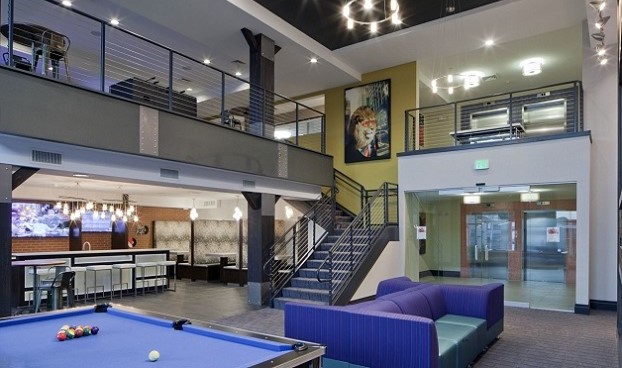
CHICAGO—The national apartment market has undergone stupendous growth in the past two years. And even though forecasters expect a more moderate level of expansion in the near future, apartment developers should continue to build at a pace above the historical average, and rents should also continue increasing.
“During the recession, there wasn't any construction going on in the apartment industry,” Nathaniel Kunes, vice president, product management, AppFolio, Inc., tells GlobeSt.com, “and I would term the last couple of years as catch-up.”
The Goleta, CA-based software provider just produced its Market Watch 2016: US Apartment Forecast, and found that annual effective rent growth has averaged 4.1% so far this year, according to Axiometrics' market intelligence. That is a bit slower than the torrid pace of 2014 and much of 2015, but still above the seven-year historical average of 2.6%.
Axiometrics has found a very strong correlation between jobs growth and apartment demand, and with the economy averaging about 200,000 new jobs each month, growth will most likely continue. But the construction boom has put so many new units into the market, about 347,000 in 2016, that supply in many markets has either caught up to or even outpaced demand.
“I think the market will stabilize, but still remain quite tight, for at least the next year or so,” says Kunes. Axiometrics forecasts that rents will rise by 3.2% for the year, a rate well above the long-term historical average.
Axiometrics and AppFolio studied 20 core markets and found that metro areas in the West and South were the strongest. In Sacramento, for example, demand has outstripped supply, says Kunes. So far this year, annual effective rent growth there was a nation-leading 11%. Portland at 10.2% was the only other area with double-digit rent growth, but considering its forecasted job growth of 2.8% in 2016, the researchers expect that renters will absorb the 4,839 new units that developers expect to finish this year.
Other cities, especially in the Midwest, have already seen supply catch up to demand, Kunes adds. In Chicago, for instance, the market will have to absorb the 7,598 new units scheduled for completion this year, even though job growth is expected to be just 1.4%. Rents will continue to grow, but at 2.2% for the year, will end up below the national average.
Student housing is the one portion of the nation's apartment market with a real mismatch between supply and demand. “There is a lot of demand that is not being met,” says Kunes. Perhaps the best explanation is that “it's a fairly new asset class.” Until the mid-1990s, there was almost no purpose-built student housing as we have come to know it. Students either lived in dorms or made do with the regular apartments available near their schools. The new resort-style apartment developments that have sprung up around university towns are “definitely a specialized sector,” and many builders feel they don't have enough knowledge or experience to jump in.
And as students head back to school this fall, it's apparent that college enrollments are growing, creating the need for yet more housing. “We could double or triple the amount of construction in student housing,” says Kunes, and still fall short of the burgeoning demand.
But overall, he believes apartment market growth will continue to be strong nationwide, although it will not hit the heights seen in the past two years. “We will start to see more normal levels of occupancy and rent growth.”
Steady gains in the US economy have resulted in net positives for the multifamily sector—will this wave continue for the foreseeable future? What's driving development and capital flows? Join us at RealShare Apartments on October 19 & 20 for impactful information from the leaders in the National multifamily space. Learn more.

CHICAGO—The national apartment market has undergone stupendous growth in the past two years. And even though forecasters expect a more moderate level of expansion in the near future, apartment developers should continue to build at a pace above the historical average, and rents should also continue increasing.
“During the recession, there wasn't any construction going on in the apartment industry,” Nathaniel Kunes, vice president, product management, AppFolio, Inc., tells GlobeSt.com, “and I would term the last couple of years as catch-up.”
The Goleta, CA-based software provider just produced its Market Watch 2016: US Apartment Forecast, and found that annual effective rent growth has averaged 4.1% so far this year, according to Axiometrics' market intelligence. That is a bit slower than the torrid pace of 2014 and much of 2015, but still above the seven-year historical average of 2.6%.
Axiometrics has found a very strong correlation between jobs growth and apartment demand, and with the economy averaging about 200,000 new jobs each month, growth will most likely continue. But the construction boom has put so many new units into the market, about 347,000 in 2016, that supply in many markets has either caught up to or even outpaced demand.
“I think the market will stabilize, but still remain quite tight, for at least the next year or so,” says Kunes. Axiometrics forecasts that rents will rise by 3.2% for the year, a rate well above the long-term historical average.
Axiometrics and AppFolio studied 20 core markets and found that metro areas in the West and South were the strongest. In Sacramento, for example, demand has outstripped supply, says Kunes. So far this year, annual effective rent growth there was a nation-leading 11%. Portland at 10.2% was the only other area with double-digit rent growth, but considering its forecasted job growth of 2.8% in 2016, the researchers expect that renters will absorb the 4,839 new units that developers expect to finish this year.
Other cities, especially in the Midwest, have already seen supply catch up to demand, Kunes adds. In Chicago, for instance, the market will have to absorb the 7,598 new units scheduled for completion this year, even though job growth is expected to be just 1.4%. Rents will continue to grow, but at 2.2% for the year, will end up below the national average.
Student housing is the one portion of the nation's apartment market with a real mismatch between supply and demand. “There is a lot of demand that is not being met,” says Kunes. Perhaps the best explanation is that “it's a fairly new asset class.” Until the mid-1990s, there was almost no purpose-built student housing as we have come to know it. Students either lived in dorms or made do with the regular apartments available near their schools. The new resort-style apartment developments that have sprung up around university towns are “definitely a specialized sector,” and many builders feel they don't have enough knowledge or experience to jump in.
And as students head back to school this fall, it's apparent that college enrollments are growing, creating the need for yet more housing. “We could double or triple the amount of construction in student housing,” says Kunes, and still fall short of the burgeoning demand.
But overall, he believes apartment market growth will continue to be strong nationwide, although it will not hit the heights seen in the past two years. “We will start to see more normal levels of occupancy and rent growth.”
Steady gains in the US economy have resulted in net positives for the multifamily sector—will this wave continue for the foreseeable future? What's driving development and capital flows? Join us at RealShare Apartments on October 19 & 20 for impactful information from the leaders in the National multifamily space. Learn more.
© Touchpoint Markets, All Rights Reserved. Request academic re-use from www.copyright.com. All other uses, submit a request to [email protected]. For more inforrmation visit Asset & Logo Licensing.








